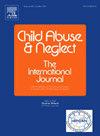学校连通性在儿童虐待与白人、黑人、拉丁裔/西班牙裔和多种族青少年内化症状之间的关系中的保护作用
IF 3.4
2区 心理学
Q1 FAMILY STUDIES
引用次数: 0
摘要
儿童虐待是一个与青少年内化症状增加相关的公共卫生问题。学校联系已被证明在儿童虐待和外化症状之间的关系中发挥保护作用;然而,它对不同种族/民族亚群体青少年内化症状的保护作用仍未得到充分探讨。目的本研究旨在探讨学校连通性是否缓冲儿童虐待对白人、黑人、拉丁裔/西班牙裔和多种族青少年内化症状的影响。参与者和环境数据来自家庭和儿童福利的未来研究,这是一项在美国20个城市进行的纵向出生队列研究,包括3021名有虐待经历的青少年。方法采用普通最小二乘回归模型分别对种族/民族亚组进行分析,以检验儿童虐待亚型和学校联系对白人、黑人、拉丁裔/西班牙裔和多种族青少年内化症状(即青少年报告的抑郁/焦虑、照顾者报告的内化症状)的交互作用。结果在所有种族/民族群体中,学校联系通常与较低水平的青少年内化症状相关。互动效应表明,仅对白人青年而言,学校联系缓和了心理攻击和照顾者报告的青年内化症状(B = - 1.46, p = 0.029)以及身体攻击和青年报告的抑郁症状(B = - 1.04, p = 0.044)之间的关系。结论:虽然学校联系与所有青少年较低的内化症状有关,但其对儿童虐待的缓冲作用在少数民族/族裔群体中不太明显。继续努力应优先考虑创造支持性的学校环境,以更好地满足有虐待史的种族/少数民族青年的需求。本文章由计算机程序翻译,如有差异,请以英文原文为准。
The protective role of school connectedness in the relationship between child maltreatment and internalizing symptoms for White, Black, Latino/Hispanic, and multiracial youth
Background
Child maltreatment is a public health concern associated with increased youth internalizing symptoms. School connectedness has been shown to play a protective role in the relationship between child maltreatment and externalizing symptoms; yet, its protective role on internalizing symptoms for youth in different racial/ethnic subgroups remains underexplored.
Objective
This study aimed to examine whether school connectedness buffers the effect of child maltreatment on internalizing symptoms for White, Black, Latino/Hispanic, and multiracial youth.
Participants and setting
Data were drawn from the Future of Families and Child Wellbeing Study, a longitudinal birth cohort study in 20 US cities, comprising 3021 youth with maltreatment experiences.
Methods
Ordinary least squares regression models were conducted separately for racial/ethnic subgroups to examine the interaction effect between child maltreatment subtypes and school connectedness on internalizing symptoms (i.e., youth-reported depression/anxiety, caregiver-reported internalizing symptoms) for White, Black, Latino/Hispanic, and multiracial youth.
Results
School connectedness was generally associated with lower levels of youth internalizing symptoms for all racial/ethnic groups. Interaction effects suggested that, for White youth only, school connectedness moderated the relationship between psychological aggression and caregiver-reported youth internalizing symptoms (B = −1.46, p = .029) and physical assault and youth-reported depressive symptoms (B = −1.04, p = .044).
Conclusions
While school connectedness was linked to lower internalizing symptoms for all youth, its buffering effects against child maltreatment were less evident among minoritized racial/ethnic groups. Continued efforts should prioritize creating supportive school contexts to better serve the needs of racially/ethnically minoritized youth with maltreatment histories.
求助全文
通过发布文献求助,成功后即可免费获取论文全文。
去求助
来源期刊

Child Abuse & Neglect
Multiple-
CiteScore
7.40
自引率
10.40%
发文量
397
期刊介绍:
Official Publication of the International Society for Prevention of Child Abuse and Neglect. Child Abuse & Neglect The International Journal, provides an international, multidisciplinary forum on all aspects of child abuse and neglect, with special emphasis on prevention and treatment; the scope extends further to all those aspects of life which either favor or hinder child development. While contributions will primarily be from the fields of psychology, psychiatry, social work, medicine, nursing, law enforcement, legislature, education, and anthropology, the Journal encourages the concerned lay individual and child-oriented advocate organizations to contribute.
 求助内容:
求助内容: 应助结果提醒方式:
应助结果提醒方式:


